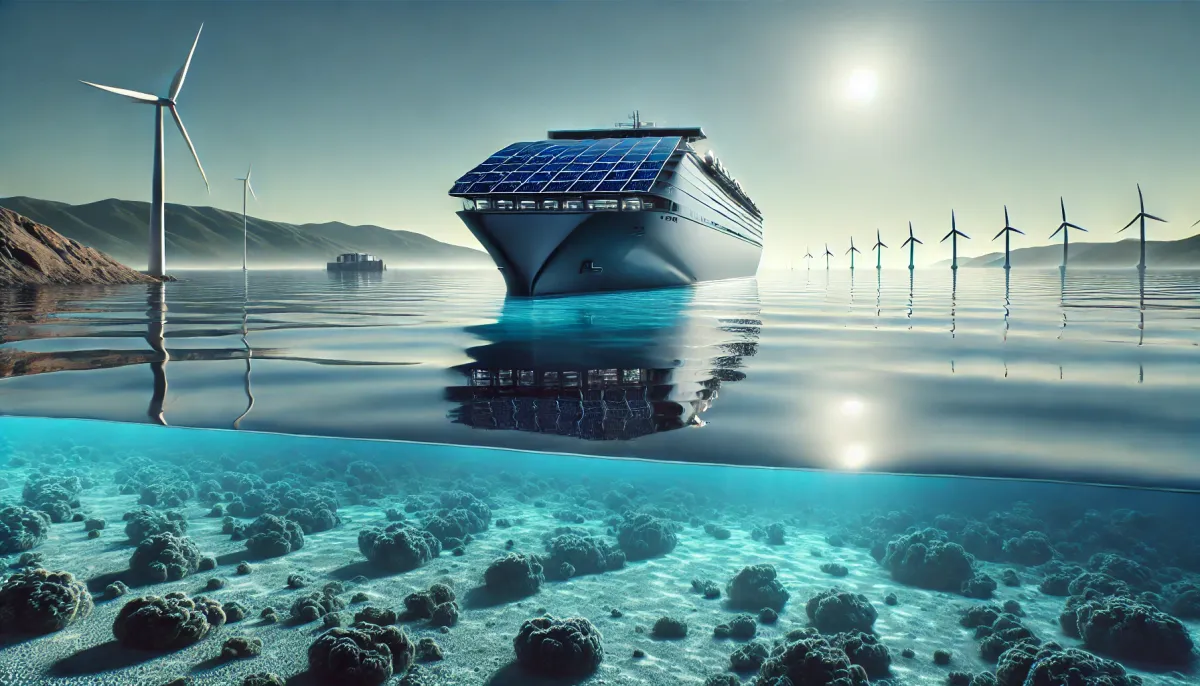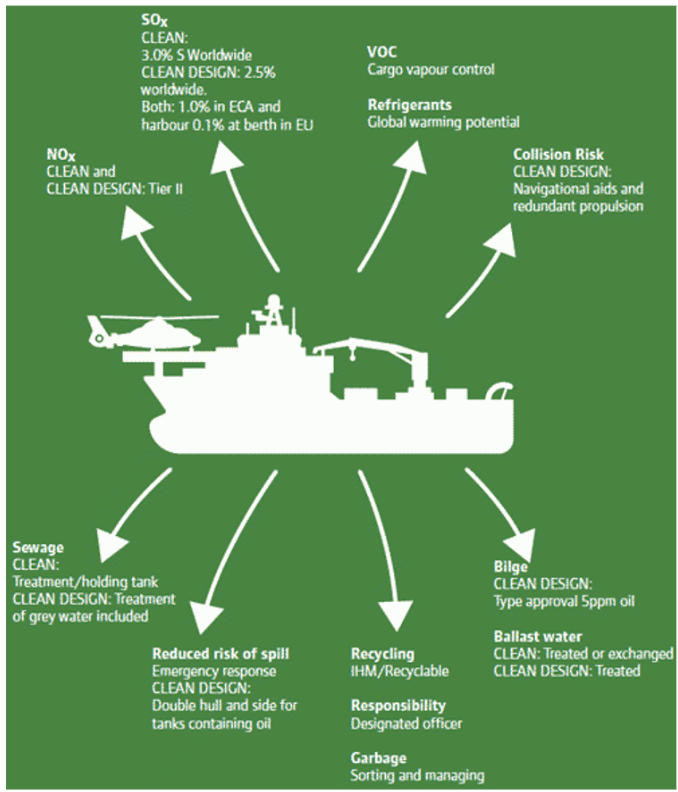Clean Ship and Clean Design: A Comprehensive Vision for Sustainable Shipping

The Growing Need for Sustainable Shipping
As the global shipping industry continues to expand, it has become increasingly evident that environmental and social costs associated with maritime transportation must be addressed. Shipping is vital to the global economy, facilitating the movement of over 80% of world trade.
However, it is also a significant contributor to environmental degradation, accounting for around 3% of global greenhouse gas (GHG) emissions, and responsible for various forms of ocean pollution, including oil spills, ballast water contamination, and hazardous waste discharge.
By adopting these approaches, the industry aims to minimize harmful discharges, reduce emissions, and ensure that ships are built, operated, and decommissioned with minimal environmental and social impacts.

Clean Ship Concept: A Holistic Approach to Ship Lifecycle Sustainability
The Clean Ship concept embodies a visionary approach to sustainable shipping by addressing all aspects of a vessel's environmental footprint from the cradle (design and construction) to the grave (operation and decommissioning).
It emphasizes the need for a holistic, integrated approach that tackles the social and environmental costs at every stage of the ship’s life cycle.
1. Tackling Environmental Costs from 'Cradle to Grave'
The Clean Ship approach focuses on reducing the environmental impact of ships throughout their entire lifespan. This includes the selection of eco-friendly materials during construction, energy-efficient technologies during operation, and responsible dismantling and recycling practices at the end of the ship's life.
By addressing issues such as air pollution, marine contamination, and waste generation from the outset, Clean Ships aim to minimize their carbon footprint and prevent the harmful discharge of pollutants into the environment.
2. Collaboration and Stakeholder Involvement
Achieving the Clean Ship vision is not a task for shipbuilders or owners alone. It requires active participation from a wide array of stakeholders, including environmental NGOs, shipbuilders, operators, regulators, and even consumers.
These diverse groups must collaborate to set new standards, drive innovation, and ensure that sustainable practices become the norm across the industry. T
The Clean Ship is more than just a technical solution; it is a collective endeavor to make shipping a more responsible and sustainable sector.
3. Key Features of a Clean Ship
- Reduced Emissions: Clean Ships are designed with cutting-edge technologies to limit harmful emissions, such as sulfur oxides (SOx), nitrogen oxides (NOx), and carbon dioxide (CO2).
- Elimination of Hazardous Discharges: These ships employ advanced waste management systems to ensure that oil, ballast water, sewage, and garbage are handled in an environmentally friendly manner, reducing pollution in the oceans.
- Energy Efficiency: The design of Clean Ships focuses on energy-efficient engines, propellers, and hull forms, helping to reduce fuel consumption and GHG emissions.
- Sustainable Materials: Construction materials are selected based on their environmental impact, ensuring that ships are built with sustainability in mind from the very beginning.
Clean Design: A Stricter Standard for Eco-Friendly Shipping
The Clean Design notation is awarded to vessels that meet the Clean Ship criteria while adhering to even more stringent environmental standards.
It was developed by Det Norske Veritas (DNV), one of the leading international certification bodies, to recognize ships that go above and beyond the minimum requirements set by the International Maritime Organization (IMO) and national regulations.
1. Emission Controls: Beyond IMO Standards
The Clean Design notation is particularly focused on limiting air and sea pollution. While the Clean notation aligns with the limits on nitrogen oxides (NOx) and sulfur oxides (SOx) emissions as stipulated in Annex VI of the International Convention for the Prevention of Pollution from Ships (MARPOL), Clean Design enforces stricter controls. Ships with Clean Design must adhere to tighter limits on emissions, making them significantly greener than their peers.
- NOx and SOx Emissions: Ships with Clean Design classification must ensure emissions are lower than the IMO-mandated levels, using technologies like exhaust gas scrubbers and selective catalytic reduction (SCR) systems.
- GHG Reduction: Clean Design ships also focus on minimizing greenhouse gas emissions through energy-efficient designs and alternative fuel usage, such as liquefied natural gas (LNG) or biofuels.
2. Enhanced Safety and Environmental Protections
In addition to emission reductions, Clean Design imposes a number of safety and environmental requirements aimed at preventing accidental pollution and mitigating the consequences of operational failures.
- Double Hull Protection for Oil Tanks: Ships must have double hulls around their oil tanks to prevent leaks in case of accidents, reducing the risk of oil spills.
- Navigational Aids: Clean Design ships are equipped with advanced navigational technologies that help reduce the likelihood of accidents, ensuring safer voyages and minimizing environmental risks.
- Alternative Propulsion Systems: Ships must have backup propulsion systems to ensure that, in case of an engine failure, the vessel can still move to prevent it from drifting into environmentally sensitive areas.
- Compliance with the Ballast Water Convention: Ships must install ballast water treatment systems to prevent the transfer of invasive aquatic species between regions, an issue that has wreaked havoc on marine ecosystems globally.
3. Water and Waste Management: Cleaner Seas
A core aspect of the Clean Design notation is stringent water and waste management.
- Bilge Water Treatment: Ships must use a 5ppm oil-water separator, a stricter requirement than the 15ppm standard set by MARPOL. This reduces oil contamination in bilge water, which is often discharged into the sea.
- Grey and Black Water Treatment: All wastewater, including grey water (from sinks and showers) and black water (from toilets), must be treated before being discharged. This reduces the impact on marine ecosystems.
- Sewage and Garbage Management: Clean Design ships are required to install advanced sewage treatment plants, and food waste cannot be discharged into these systems. Instead, proper waste disposal procedures are mandated to reduce marine pollution.
4. New Criteria for Clean Design (Effective from July 1, 2011)
The Clean Design criteria were further upgraded in 2011 to meet evolving environmental challenges. Key updates include:
- IHM/Recyclable Compliance: Ships must maintain an inventory of hazardous materials (IHM) to ensure compliance with the Hong Kong Convention for the Safe and Environmentally Sound Recycling of Ships.
- Stern Tube Lubrication: Only water or biodegradable lubrication is permitted in the stern tube, preventing oil pollution in the ocean.
- Cold Ironing: Clean Design ships can opt for cold ironing, which allows them to plug into shore-side electrical power while in port, reducing emissions from the ship’s engine.
The Future of Sustainable Shipping: Clean (Tier III) and Clean Design (Tier III)
The Clean and Clean Design notations are evolving as the shipping industry adopts new technologies to comply with the IMO's Tier III emission standards. Vessels that meet these standards—by installing certified engines that reduce NOx emissions—are eligible for the Clean (Tier III) or Clean Design (Tier III) notations.
Charting the Course for a Greener Maritime Industry
The Clean Ship and Clean Design concepts represent a significant leap forward in the maritime industry's efforts to address its environmental impact. By setting rigorous standards for emissions, waste management, and safety, these initiatives push the boundaries of what is possible in sustainable shipping.
They challenge shipbuilders, owners, and operators to adopt cleaner, greener practices that reduce their environmental footprint while maintaining the efficiency and safety of maritime transportation.
As shipping companies continue to adopt Clean and Clean Design notations, they will play a vital role in shaping a future where ships are not only essential to global commerce but also protectors of the oceans and the environment.